Buy Carnivorous Plants Online!
Buy carnivorous plants from the most reputable and trusted carnivorous plant nursery, California Carnivores. We have partnered up and are giving all my viewers an exclusive 10% discount on your entire carnivorous plant order! Just enter CPHUB at checkout! Get the coolest venus flytrap cultivars, sarracenia, nepenthes and much MUCH more! You can even buy your next bag of premium carnivorous plant soil from them! Order Plant Mail, Click Here!| We are a participant in the Amazon Services LLC Associates Program, an affiliate advertising program designed to provide a means for sites to earn advertising fees by advertising and linking to Amazon.com. |
Today we are going to talk about the best venus flytrap soil mix. Venus flytraps are very picky when it comes to soil and won’t live if you don’t get a very specific mix for potting. If you go outside in your backyard and grab some soil or buy your typical potting soil at the market it will quickly kill a venus flytrap. I want to make sure you have the best soil for a venus flytrap there is!
We are also going to dig into (see what I did there?) how to repot a venus flytrap from whatever it came in to your new pot. Were even going to talk a little bit about how to pick out a pot for your venus flytrap. And how often you should repot your venus flytrap.
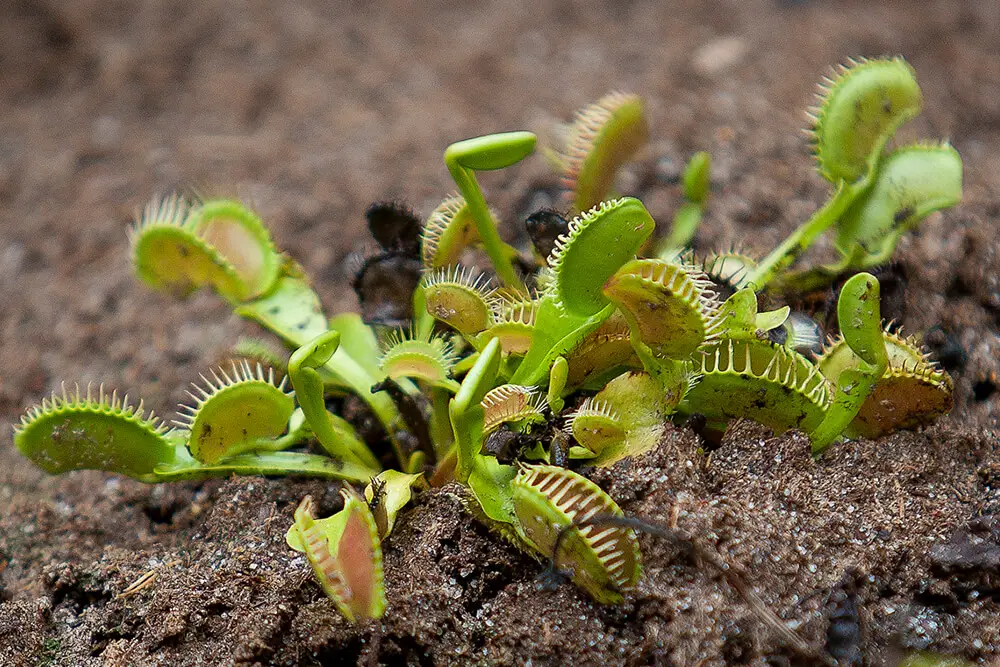
I’m going to deep dive into the best soil for venus flytraps below but I wanted to give you the quick answer before we get too far in.
I have looked high and low and read many, many comments on everyone’s favorite venus flytrap soil mix for potting. This is the soil recipe that I found most common and most successful.
Make sure to also check out my venus fly trap ultimate caring guide below. Learn everything you need to know about venus flytrap care.
Ultimate Venus Fly Trap Care Guide
Best Venus Flytrap Soil Mix
The best and most recommended venus flytrap soil mixture is 5 parts peat moss, 3 parts silica sand and 2 parts perlite. Aeration is important with venus flytraps and the silica sand really helps with creating a drainage and a healthy root system. You may also see silica sand referred to as white sand, silicon dioxide or just silica.
The reason the silica sand is acceptable is it’s a very hard mineral and is not soluble, it won’t release any additional minerals into the soil.
Now that you have the quick answer, lets talk more about what each ingredient means and why they are important. Lets also talk about what a venus flytrap needs from it’s soil mixture.
Also, before going too far, check out some of the other guides/information I have written right here on this website. You will find everything you need to take care of your venus fly trap!
How Does A Venus Flytrap Work?
Picking A Pot or Planter For Venus Flytrap
Venus Flytrap Dormancy (Yes, they hibernate and yes you need to know about it!)
What/How To Feed A Venus Flytrap – How to feed and what to feed a venus flytrap!
Venus Fly Trap Watering Guide – Learn how often and what kind of water to give your plant!
30 Interesting Venus Flytrap Facts
What A Venus Flytrap Needs From Soil
This is kind of a misleading questions in a way considering it’s almost easier to say what does a venus flytrap not need from it’s soil. The answer you might not be expecting is nutrients. The soil needs to be void of any minerals or nutrients which is very opposite of most plants and goes against our typical planting knowledge.
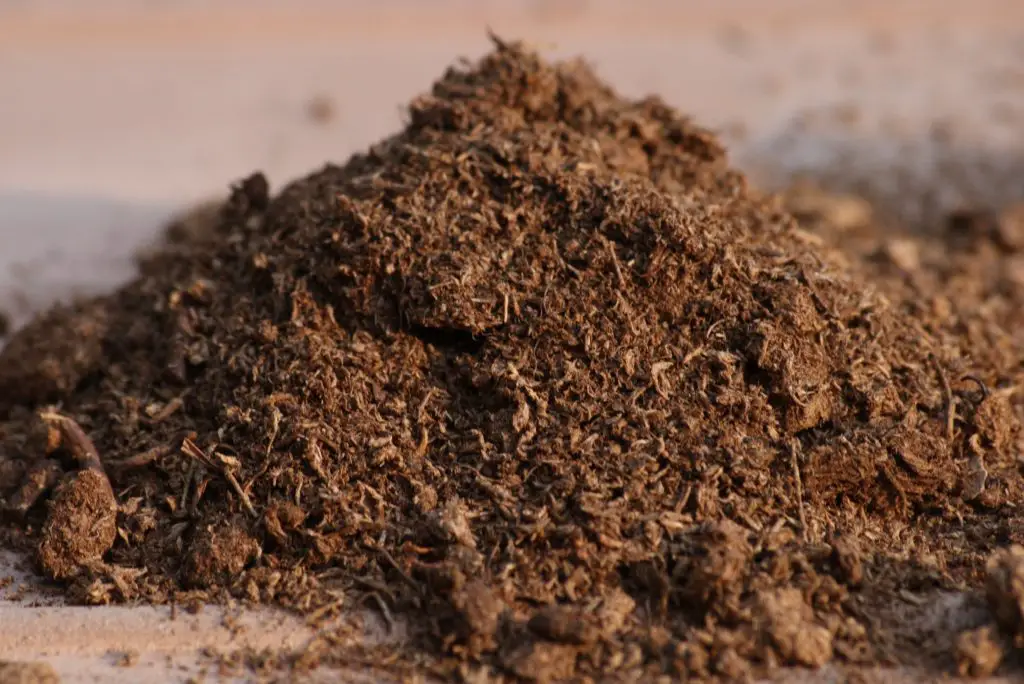
The most important part of picking the right soil for a venus flytrap is making sure the soil is very nutrient poor. If you use regular potting soil or just plant the venus flytraps into the ground they nutrients in the soil will burn the roots and eventually kill the plant.
There are some experts who use a very diluted fertilizer on the leaves but it’s extremely risky and can go wrong very easily if your not experienced. This is not suggested for anyone starting out growing venus flytraps.
Let’s talk about each ingredient individually for a bit.
Peat Moss
Peat moss is great for venus flytraps due to it being very nutrient poor. Please make sure you don’t get anything that’s “Enriched” this means nutrients have been added. It’s easy to obtain as you can get it at just about any store that carries any kind of soil. Whether it’s big box or a local nursery you shouldn’t have any problems finding it.
Using a long fibered sphagnum moss can really help prevent the perlite from floating to the top during watering and heavy rains. This is something to keep in mind when picking out the peat moss, but isn’t absolutely necessary.
Watch out for the brand of peat moss you get. I know that Miracle-Gro and Scott’s both contain fertilizer which will kill the venus flytrap, so try to avoid those.
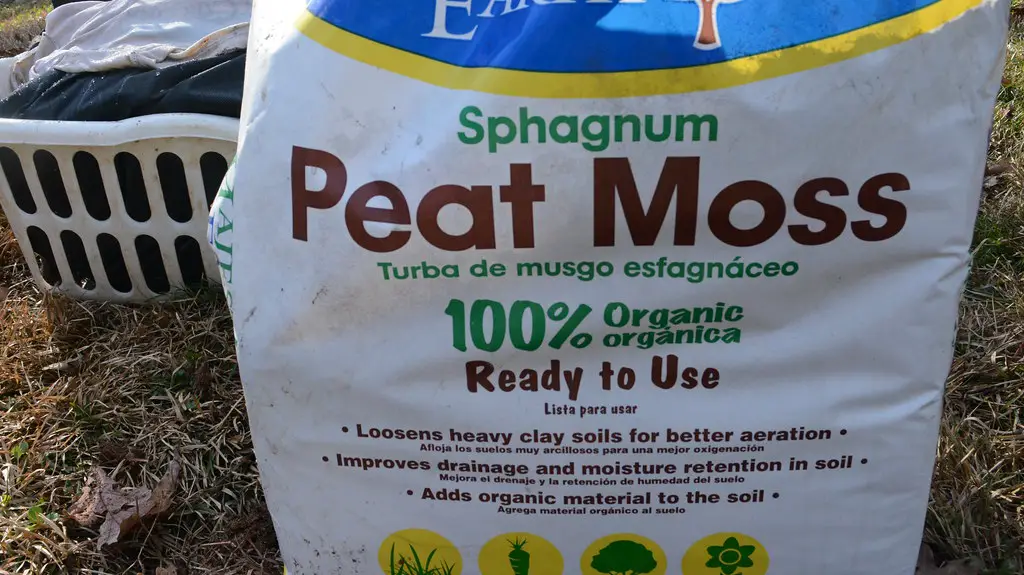
Perlite
Perlite is a volcanic glass that has high water content. This helps it aid in water retention and aeration. It also modifies the soils substructure keeping it loose, well drained and keeps it from getting too compact. Perlite is optimum for growing in a container it enables the pot to hold just enough water and oxygen.
Perlite is also going to be pretty easy to find, you will be able to get some at big box stores, local hardware stores and likely at local nursery’s.
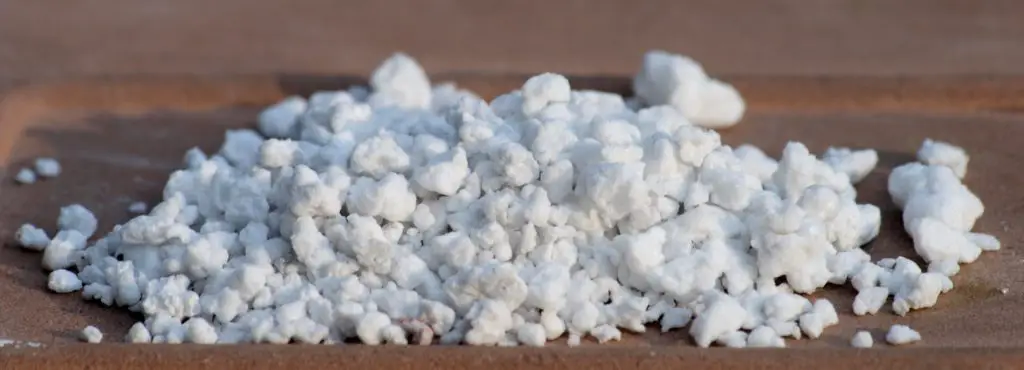
Silica Sand
Silica sand is is a very hard mineral but it’s not soluble and it’s completely neutral. This basically means that it’s great for venus flytraps because it won’t release any minerals into the soil. It can really help with the formation of a healthy root system as well as promoting great aeration.
It’s also known as white sand, silica quartz and silicon dioxide. You will have the best luck finding silica sand at your local hardware store. I know that places like Lowes and Home Depot will have some available.
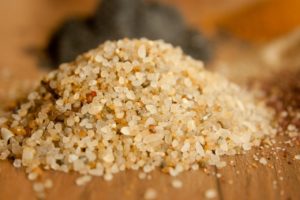
Mixing The Soil
Okay, now that we have talked about the ingredients to the best soil for venus flytrap lets talk about what to do with them.
Clean And Rinse The Silica And Perlite
I would recommend soaking the silica sand and perlite in distilled water. This will help get the dust off and prevent any unwanted minerals from entering the soil. I’ve heard of people talk about soaking the peat moss as well, but this seems like overkill and has never been an issue for me.
To do this just dump the sand and perlite into a plastic container or bucket. Poor enough water in to cover the silica and perlite. Swirl the water around for a bit and dump it out. Do this again until the water appears to be clear. Keep in mind, when you dump the water in and it’s clear you can reuse this water as it should still be clean.
Mixing The Soil (For Real)
Now your ready to start mixing all the ingredients. Add 5 parts peat moss, 3 parts silica sand and 2 parts perlite by volume.
Once all ingredients are added you will want to add some distilled water. It’s going to take more water than you think due to the perlite and peat moss being very absorbent. Keep adding and mixing together you will want to make sure that the peat moss gets completely saturated and that the perlite is all mixed in.
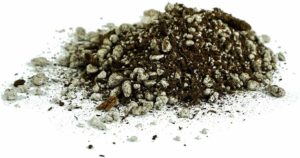
At first the peat moss may seem to avoid the water and it might not soak up well. Keep mixing and the peat moss will eventually soak up the water. If it’s cold it will be even worse, so just mix and be patient!
Once your all mixed up your ready to go! Your venus flytrap soil mis is ready and it’s time to start potting.
Pre Mixed Venus Fltyrap Soil
Life is busy you don’t have time to get all these different parts then clean and finally mix. Trust me, I have 3 kids, I COMPLETELY understand. If you want to grab a premixed soil you definitely have options.
Keep in mind, I believe the mix I presented to you is the best venus flytrap soil mix but there are more than one way to do this. The mixes may not be exactly the same as mine but you should be able to find something that works for you. Even Amazon has soil mixes you can buy.
If your not looking to pot a lot of venus fltyraps you probably don’t need to make a ton of your own soil mix. Take a look at the link below to see the soil mix I recommend on Amazon.
Venus Flytrap Soil Mix On Amazon
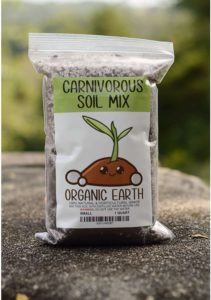
Choosing A Pot For Venus Flytrap
Now that we made the best venus flytrap soil mix, I’m going to talk quickly about what to look for when choosing a pot or planter for your venus flytrap.
Just the other day I actually spent hours working on an article all about choosing the right pot and what to look for, check that out below. I’ll paraphrase that article below but if you really want to deep dive and see some good examples, the article is great!
Best Pots And Planters For Carnivorous Plants
Make sure you get a pot that has good drainage holes for your venus flytrap. One of the best ways to keep them watered is with drainage holes and keeping the tray under the pot full of water. If the pot doesn’t have good drainage your venus flytrap will likely end up rotting at the roots.
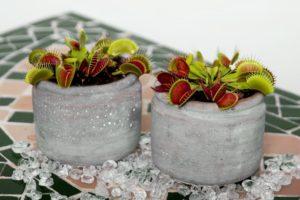
You also want to make sure and look for something that is light in color. In the summer you don’t want your venus flytrap’s roots baking in a black pot. The lighter the color the less sun it will absorb keeping the roots nice and cool.
Avoid any kind of pot that is unglazed. The terracotta planters for example are very porous and can actually steal the moisture and dry out the soil. These pots can also leach unwanted minerals into the soil. If you need the look of terracotta grab a resin or plastic pot that mimics the look.
Make sure the planters are fully glazed. Some are glazed on the outside but not the inside.
Venus Flytrap Pots To Look For
Look for anything that is made out of resin or plastic. These will work the best. I have also seen some really neat fully glazed ceramic pots. These are great as long a they are fully glazed. I prefer the resin or plastic, you can check out some really nice resin and plastic pots below.
Just keep in mind that its very important to pick something that has good drainage holes. Most good planters and pots these days will have a drainage hole with a plug so you can choose to drain or not.
Resin Pots On Amazon
Plastic Pots On Amazon
Fully Glazed Ceramic Pots On Amazon
Now that you have picked out your pot and made the best soil for venus flytrap lets talk about how to plant!
How To Repot A Venus Flytrap
Alright, so you picked out the perfect pot for your venus flytrap. You either made or bought a great venus flytrap soil mix. You are ready to repot your plant to your custom soil mix and brand new pot!
Lets break this down into steps. It’s really not that hard to repot a venus flytrap but I’ll still break it down into steps for you below just to make it as easy as possible.
To start off find a good work area, somewhere you are not worried about making a huge mess. If you can repot outside, this is probably best.
Before we get started its important that you know what the rhizome is. The rhizome is the bulb-like white part that is just below the soil but just above the black roots. If you research plants especially plants that you can propagate the rhizome will come up a lot. Most of the leaves from the venus flytrap originate from the rhizome and this is where the plant stores its energy.
Steps To Repotting A Venus Flytrap
I wanted to outline some really easy steps for you below. This isn’t a super complicated process but it helps to see each step. Honestly, your going to remove the venus flytrap from the container its in. Clean off the roots of any soil or debris and put it in the new venus flytrap soil you made or bought. That’s the jist but I’ll break it down below.
Get The New Pot Ready
Here we go! You created the best soil for venus flytrap and now it’s time to introduce your plant to your soil. Grab some of your prepared soil and put in in your planter or pot. Fill it to the top then compress it a bit. Using your finger or possibly some other tool make a hole that is pretty deep. You want it to be deep enough that the roots and the rhizome have a lot of room to grow. Make sure the hole is deep enough that you don’t have to loop up the roots to get the venus flytrap to fit. It’s important to make the top of the hole a little larger so the rhizome can fit.
Uprooting And Preparing The Plant
Just like with other plants, gently squeeze the side of the plastic planter it came in. This helps release the soil from the planter. You will then turn the pot over and release the plant from it’s current pot. Make sure to hold it in a way that you don’t drop the plant.
Once it’s free, start breaking the soil away from the roots of the venus flytrap. Go very slow and be very patience with this process. If you were going to hurt your venus flytrap during repotting, this would be the time. You can also plunge the roots into some distilled or rain water to help release the soil from the roots. Just swirl it around a bit and the soil should just fall off.
Place Into The New Pot
The venus flytrap is now exposed and the soil is completely off the roots and rhizome. It’s time to repot it into it’s new home. The key to this part is to get the roots as deep into the hole you dug as possible. Use a stick or screwdriver to guide the roots as far into the hole as possible. You may need to adjust the depth of your hole at this point if the roots don’t go very deep. You will want the rhizome just below the soil in the hold you made.
Compact The Soil
Next, you will compact the soil around the rhizome. Do this very gently but do make sure to press it enough so that its snugly fit to the rhizome. You may want to grab some extra venus flytrap soil mix to put in around the rhizome. It shouldn’t be super deep but the white of the rhizome should be completely covered.
Give The Venus Flytrap A Big Drink Of Water
It’s been a long day for your venus flytrap, its finally time for it to rest a bit and have a drink. After a hard days work, don’t we all? Watering immediately helps eliminate any air pockets that may have developed. It can also help reduce any root shock that may have occurred from the repotting process.
It’s important to water gently from the top this will help reduce the chances of the perlite and silica (if used) from rising to the top of the pot. The harder the water hits the more the peat moss will want to separate from the perlite. You can even pour the water right onto the plant itself and allow the water to trickle into the soil. The soil should be pretty saturated on this initial watering.
Venus Flytrap Soil Q&A
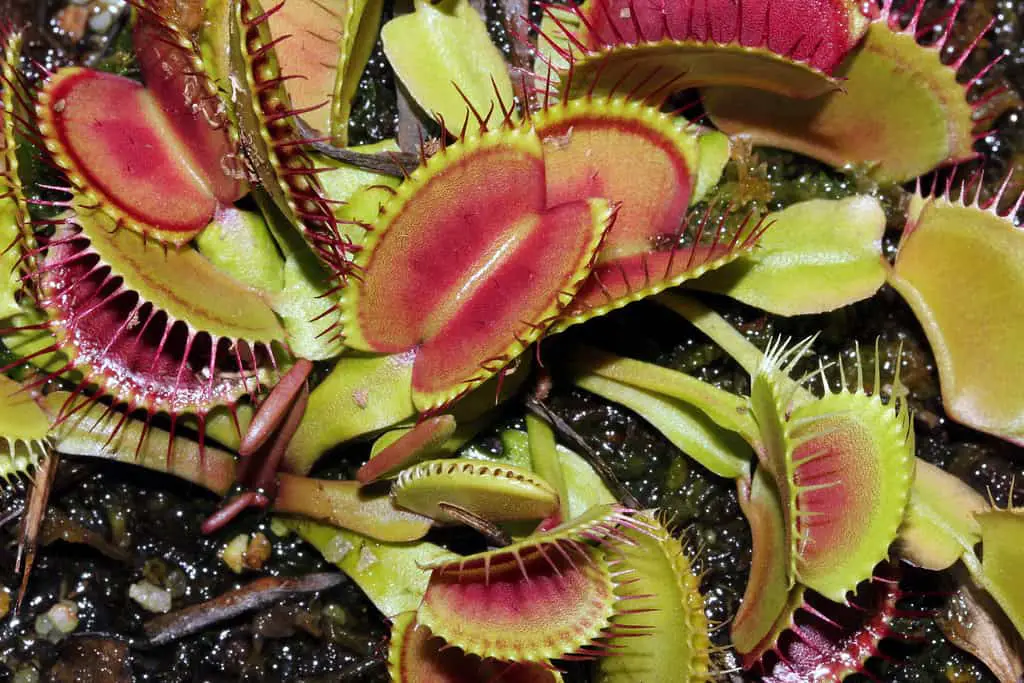
Before getting to the end of teaching you about the best soil for venus flytraps and how to repot, I wanted to do a little Q&A. I think most of the questions and answers are sprinkled above but it’s nice to have all the biggest questions answered in one area.
Where To Buy Venus Flytrap Soil?
You can make your own or you can simply buy it from a local nursery or even Amazon. Amazon has some great carnivorous plant and venus flytrap soil mixes to choose from. Check the link below to see where you can buy venus flytrap soil on Amazon.
Venus Flytrap Soil On Amazon
Just make sure it’s at the very least a peat moss and perlite mix. Most importantly make sure none of the ingredients have been enriched.
How Much Soil Does My Venus Flytrap Need?
This wasn’t covered much above. This will all depend the size of the pot and size of your venus flytrap. I did talk about how you need to fill your planter to the top and compress it down. So at least enough to fill the pot you purchased for your venus flytrap and plus a little extra in case you have a spill or need it.
Can Venus Flytraps Live In Normal Soil?
This one is a hard no. Venus flytraps come from bogs where the soil has very little nutrients. This is why the venus flytrap catches insects and eats them, they don’t obtain nutrients or energy from their roots. If the soil has normal amounts or is enriched with fertilizer or nutrients it will burn the roots and likely be a quick death for your plant.
When Should I Repot My Venus Flytrap?
Aside from your initial repotting a venus flytrap does like to be repotted once a year. The media (Soil) can get hard and compact making it hard for the roots to thrive and grow. Repotting will keep your venus flytrap soil aerated and fresh. The best time of year is to repot in early spring which is about the time they are coming out of dormancy. I also spent a lot of time writing an article all about dormancy, check it out!
Read All About Venus Flytrap Dormancy Here!
I think that covers most of the questions you might ask.
Best Venus Flytrap Soil And Repot Venus Flytrap Conclusion
Thank you so much for stopping by and learning all about venus flytrap soil mixes and information. These plants are truly special and I’m happy your here to give your venus flytrap the best home you possibly can. I hope your
If this was helpful to you, please make sure to share on your favorite social medial platform. Facebook, Pinterest or Instgram, whatever you like best. If you have a website, feel free to link back to this info!
Thank you for all your support and may all your plants venus flytrap plants thrive and lead a healthy long life!


